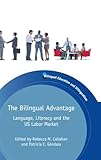TheBilingual Advantage : Language, Literacy and the US Labor Market / ed. by Rebecca M. Callahan, Patricia C. Gándara.
Material type: TextSeries: Bilingual Education & BilingualismPublisher: Bristol ; Blue Ridge Summit : Multilingual Matters, [2014]Copyright date: ©2014Description: 1 online resource (280 p.)Content type:
TextSeries: Bilingual Education & BilingualismPublisher: Bristol ; Blue Ridge Summit : Multilingual Matters, [2014]Copyright date: ©2014Description: 1 online resource (280 p.)Content type: - 9781783092420
- 9781783092437
- Career education -- United States
- Education, Bilingual -- United States
- English language -- Business English -- Study and teaching
- English language -- Study and teaching (Higher) -- Foreign speakers
- English language -- Study and teaching (Higher) -- United States
- English language -- Study and teaching (Higher) -- United States
- English language -- Technical English -- Study and teaching
- Interdisciplinary approach in education -- United States
- Interdisciplinary approach in education -- United States
- Literacy -- United States
- Vocational education -- United States
- LANGUAGE ARTS & DISCIPLINES / Linguistics / General
- 428.0071/073 23
- PE1068.U5 B55 2014
- PE1068.U5 B55 2014
- online - DeGruyter
- Issued also in print.
| Item type | Current library | Call number | URL | Status | Notes | Barcode | |
|---|---|---|---|---|---|---|---|
 eBook
eBook
|
Biblioteca "Angelicum" Pont. Univ. S.Tommaso d'Aquino Nuvola online | online - DeGruyter (Browse shelf(Opens below)) | Online access | Not for loan (Accesso limitato) | Accesso per gli utenti autorizzati / Access for authorized users | (dgr)9781783092437 |
Frontmatter -- Contents -- Contributors -- Section 1: Bilingualism in the US Labor Market -- 1. Contextualizing Bilingualism in the Labor Market: New Destinations, Established Enclaves and the Information Age -- 2. Benefits of Bilingualism: In the Eye of the Beholder? -- 3. Exploring Bilingualism, Literacy, Employability and Income Levels among Latinos in the United States -- Section 2: Are There Really Economic Benefits to Bilingualism in the US Labor Market? -- 4. Labor Market Differences Between Bilingual and Monolingual Hispanics -- 5. The Occupational Location of Spanish-English Bilinguals in the New Information Economy: The Health and Criminal Justice Sectors in the US Borderlands with Mexico -- 6. Returns to Spanish-English Bilingualism in the New Information Economy: The Health and Criminal Justice Sectors in the Texas Border and Dallas-Tarrant Counties -- 7. The Literal Cost of Language Assimilation for the Children of Immigration: The Effects of Bilingualism on Labor Market Outcomes -- 8. English Plus: Exploring the Socioeconomic Benefits of Bilingualism in Southern California -- Section 3: Employment, Educational Attainment and Bilingualism -- 9. Bilinguals in the US and College Enrollment -- 10. Employer Preferences: Do Bilingual Applicants and Employees Experience an Advantage? -- Section 4: Policy Options: Fostering Bilingualism in the Market Place -- 11. The International Baccalaureate: A College Preparat ory Pathway for Heritage Language Speakers and Immigrant Youth -- 12. Looking Toward the Future: Opportunities in a Shifting Linguistic Landscape -- Index
restricted access online access with authorization star
http://purl.org/coar/access_right/c_16ec
The Bilingual Advantage draws together researchers from education, economics, sociology, anthropology and linguistics to examine the economic and employment benefits of bilingualism in the US labor market, countering past research that shows no such benefits exist. Collectively, the authors draw on novel methodological approaches and new data to examine the economics of bilingualism for the new generation of bilinguals entering a digital-age globalized workforce. The authors also pay considerable attention to how to best capture measures of bilingualism and biliteracy, given the constraints of most existing datasets.
Issued also in print.
Mode of access: Internet via World Wide Web.
In English.
Description based on online resource; title from PDF title page (publisher's Web site, viewed 24. Apr 2022)


